Laboratories Face Change in the Digital Age
From - Diagnostic Testing & Emerging Technologies Like all other industries, the laboratory industry will feel the effects of the digital revolution. In some cases, digital technology will make operations more efficient and cut human errors by… . . . read more

Subscribe to Clinical Diagnostics Insider to view
Start a Free Trial for immediate access to this article